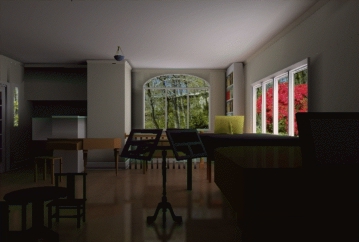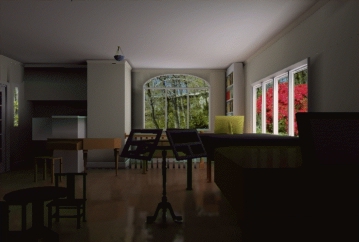 |
 |
| Geometry-based reflections | Image-based reflections |








Increased Photorealism for Architectural Walkthroughs
Architectural walkthrough systems are expected to provide convincingly realistic and interactive visualizations of complex virtual environments. Unfortunately, many architectural walkthrough systems lack view-dependent information which can be an important tool in understanding the spatial relationships among objects in a scene.
One common approach to adding view-dependent illumination
to an architectual model is to use geometric multi-pass rendering.
An initial pass renders the view-independent model. An additional rendering
pass renders the reflected model for each surface with specular attributes.
While this approach works well for small models, it is unsuitable for most
architectural models.
 |
 |
| Geometry-based reflections | Image-based reflections |
We have developed a hybrid geometry- and image-based approach which uses images to produce interactive reflections. As a preprocess, we compute a set of radiance maps (images with depth) that represents what each reflective surface "sees". Each pixel in a radiance map stores the radiance and location of a point in 3D space - a point on the surface intersected by the corresponding viewing ray. These radiance maps are rapidly generated using standard graphics hardware. At run-time, a subset of radiance maps is selected and reprojected onto the reflective surface. Pixels of the radiance maps are transformed into world space (using the inverse transformation used to compute the radiance map) and then projected into the new view. Since each pixel represents a point in 3D space, the transformation and reprojection operations are performed using standard graphics hardware.
This image-based approach outperforms geometry-based reflections and
provides reasonable results for glossy surfaces.
Related Publications
R. Bastos, K. Hoff, W. Wynn, and A. Lastra. Increased Photorealism for Interactive Architectual Walkthroughs, Proceedings of the 1999 Symposium on Interactive 3D Graphics (Atlanta, GA), April 26-28, 1999.
R. Bastos and W. Stuerzlinger. Forward Mapped Planar Mirror Reflections, University of North Carolina at Chapel Hill, Technical Report TR98-026, April 1998.


Maintained by William C. Wynn
Last Modified 18
Feb 1999